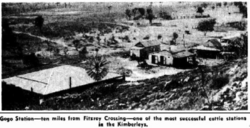Gogo Formation facts for kids
Quick facts for kids Gogo FormationStratigraphic range: Frasnian |
|
|---|---|
| Type | Geological formation |
| Underlies | Virgin Hills Formation |
| Overlies | Unconformity with Prices Creek Group |
| Thickness | Up to 700 m (2,300 ft) |
| Lithology | |
| Primary | Shale, Siltstone |
| Other | Limestone |
| Location | |
| Location | Kimberley, Western Australia |
| Coordinates | 18°18′S 126°30′E / 18.3°S 126.5°E |
| Approximate paleocoordinates | 16°42′S 136°42′E / 16.7°S 136.7°E |
| Region | Western Australia |
| Country | |
| Type section | |
| Named for | Gogo Station |
| Thickness at type section | ~425 m (1,394 ft) |
The Gogo Formation is a special rock layer in the Kimberley region of Western Australia. It's famous for having incredibly well-preserved fossils from an ancient Devonian reef. This place is called a Lagerstätte, which means it's a fossil site with amazing preservation.
The formation gets its name from Gogo Station. This is a large cattle ranch where these rocks and fossils are often found. Another nearby place where fossils are collected is Fossil Downs Station.
Contents
Discovering the Gogo Formation
The ancient reef, which now looks like rocky hills in the Australian desert, was first found in 1940. A scientist named Curt Teichert identified it. He was the first to discover fossil fish in this area.
What the Gogo Rocks Are Made Of
The Gogo Formation is mostly made of siltstone and shale. These are types of fine-grained rocks. It also has some limestone, which is a rock made from the shells and skeletons of sea creatures.
You can find many round, hard concretions here. These are like natural rock "balls" that formed around objects. They are tougher than the surrounding rock. When the softer rock wears away, these concretions are left behind.
The Gogo sediments formed in deep ocean waters. These waters had very little oxygen, which helped preserve the fossils. This area was once a large tropical reef. It was made mostly of algae and stromatoporoids (sponge-like creatures). This was during the Frasnian time, a period in the Late Devonian.
When the Gogo Formation Formed
The Gogo Formation rocks were laid down during the Frasnian period. This was a part of the Late Devonian era, a very long time ago.
Amazing Fossil Preservation
The fossils found in the Gogo Formation are truly special. They show incredible three-dimensional preservation. Even delicate parts like nerves and tiny embryos with umbilical cords have been found. This is very rare in the fossil record.
Scientists have found over fifty different kinds of fish fossils here. Other creatures like phyllocarids (ancient shrimp-like animals) and eurypterids (sea scorpions) are also well-preserved. While other fossils like nautiloids are found, their soft parts are not preserved.
The hard concretions formed around dead animals that sank from the shallow reef into the deep, oxygen-poor waters. Because there was little oxygen, the bodies decayed very slowly. This allowed the concretions to form quickly around them, keeping their shapes.
Scientists use a special method to get the fossils out. They put the concretions in a weak acid solution. The acid slowly dissolves the rock matrix, revealing the delicate fish fossils inside. Some fossils even show impressions of soft tissues!
One of the most exciting discoveries was Materpiscis. This was a type of armored fish called a placoderm. It was found with a baby fish still attached by its umbilical cord. This showed that some placoderms gave birth to live young, just like some animals today.
What Kinds of Fossils Are Found?
The Gogo Formation is rich in many types of ancient sea creatures. Here are some of the main groups found:
Armored Fish (Placodermi)
Many different kinds of placoderms have been found. These were ancient fish with bony armor plates.
- Bothriolepis
- Bruntonichthys
- Campbellodus
- Eastmanosteus
- Fallacosteus
- Materpiscis (famous for live birth discovery)
- Rolfosteus
Ray-Finned Fish (Actinopterygii)
These are early forms of ray-finned fish, a group that includes most modern fish.
- Gogosardina
- Mimipiscis
- Moythomasia
Cartilaginous Fish (Chondrichthyes)
This group includes sharks and rays.
- Gogoselachus (an early shark)
Lobe-Finned Fish (Sarcopterygii)
These fish have fleshy, lobed fins. This group includes lungfish and the ancestors of land animals.
- Chirodipterus
- Gogonasus (important for understanding how fish evolved into land animals)
- Griphognathus
- Onychodus
Arthropods
Many different arthropods, which are creatures with exoskeletons like insects and crustaceans, have been found.
- Montecaris (a large, shrimp-like phyllocarid)
- Concavicaris (a thylacocephalan, an unusual group of arthropods)
- Adelophthalmus (a type of eurypterid or sea scorpion)
- Mushia (a common, but still mysterious, arthropod)
Other Fossils
Other fossils found include:
- Corals
- Conodonts (tiny, tooth-like fossils from eel-like creatures)
- Ammonoids (ancient relatives of squid and octopuses)
Images for kids
See also
 In Spanish: Formación Gogo para niños
In Spanish: Formación Gogo para niños


























